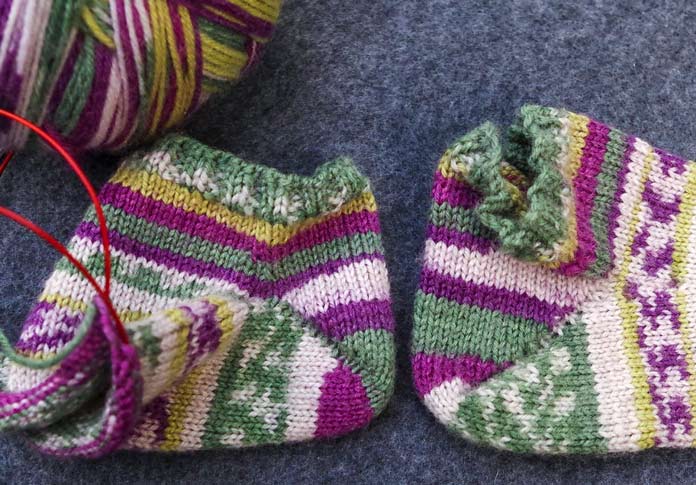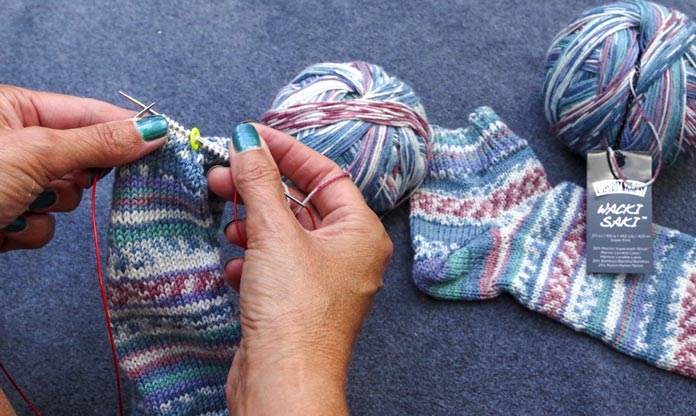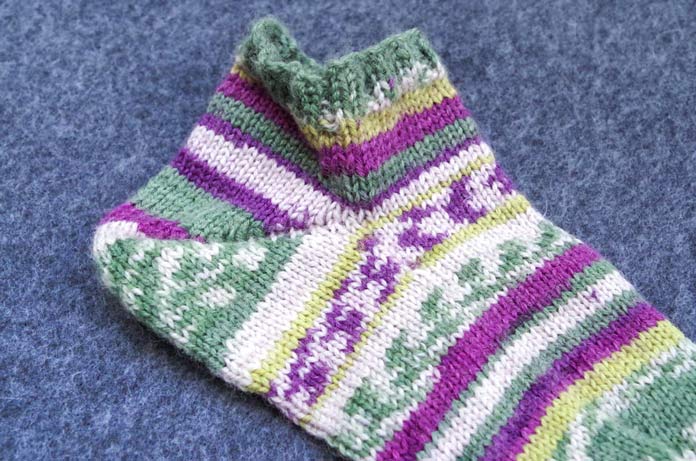After experimenting with several needle sizes and Wisdom Yarn Wacki Saki, my wife and I each knit a pair of socks using German short row heels. Each of us chose a different gauge, which I reviewed yesterday. Today, I’ll share the pattern for these socks and a video on how to work the German Short row stitches.

At a gauge of 30 to 32 stitches per 4″, it’s possible to knit 4 ankle length socks out of one ball of Wacki Saki sock yarn.
I wrote this pattern for 56 stitches and size 2US [2.5mm if you can find them, or 2.75mm] needles. You can either use one long needle and the magic loop method, 2 circular needles, or 4 dpns. It’s up to you. The instructions aren’t written to favor one technique.
These are cuff-down socks, so you will need to be prepared to graft the toes. However, if you’re more of a toe-up person, these heels are completely reversible as long as you add the 4 stitches for the instep before you work the heels, and decrease them afterwards.

The faux Fair Isle patterns that work up with the space-dyed Wacki Sacki yarn look good at any gauge.
Cast on 56 sts using cable cast on.
Work ribbing as follows:
Round 1: [K1tbl, p1], rep between [ ] around.
Rep Round 1 11 more times.
Next: Knit for 1 inch.
Set-up Rounds for Short-Row Heel.
Rnd 1: K28, k2, m1, k24, m1, k2—58 sts on needle.
Rnd 2: Knit around.
Rnd 3: K28, k3, m1, k2, m1, k3—60 sts on needle.
Rnd 4: Knit around.
Rnd 5: K30 and place these stitches “on hold” on waste yarn or a spare dpn, k28, turn leaving rem 2 sts on needle unworked.

Just 4 stitches are added to make a mini gusset before the short-row heels are knit.
Heel Rows
Row 1: Yarn should already be at front of work as this is purl side, slip first st purlwise (as if to purl), tug on yarn to the right and take over right-hand needle to the back, bring yarn up through both needle tips, give it one more tug, (this is known as the purl hitch-stitch-abbrev: ph-st), purl next 25 sts, turn, leaving rem 2 sts on needle unworked.
Row 2: Bring yarn forward, slip st purlwise, tug on yarn to the right and take over the right-hand needle to the back, give it one more tug (this is known as the knit hitch-stitch-abbrev: kh-st), knit next 24 sts, turn, leaving rem sts on needle.
Row 3: Ph-st, p23, turn.
Row 4: Kh-st, k22, turn.
Row 5: Ph-st, p21, turn.
Row 6: Kh-st, k20, turn.
Row 7: Ph-st, p19, turn.
Row 8: Kh-st, k18, turn.
Row 9: Ph-st, p17, turn.
Row 10: Kh-st, k16, turn.
Row 11: Ph-st, p15, turn.
Row 12: Kh-st, k14, turn.
Row 13: Ph-st, p13, turn.
Row 14: Kh-st, k12, turn.
Row 15: Ph-st, p11, turn.
Row 16: Kh-st, k10, turn.
Row 17: Ph-st, p9, [purl into both strands of next hitch stitch (check the German Short Rows video for this)] 8 times, p1, turn, leaving 1 rem st.
Row 18: Kh-st, k17, [knit into both strands of next hitch stitch (check the German Short Rows video for this)] 9 times, k1, turn, leaving rem st unworked.
Row 19: Ph-st, p19, turn.
Row 20: Kh-st, k11, turn.
Row 21: Ph-st, p10, p2tog-hitch, p1, turn.
Row 22: Kh-st, k11, k2tog-hitch, k1, turn.
Row 23: Ph-st, p12, p2tog (hitch), p1, turn.
Row 24: Kh-st, k13, k2tog(hitch), k1, turn.
Row 25: Ph-st, p14, p2tog(hitch), p1, turn.
Row 26: Kh-st, k15, k2tog(hitch), k1, turn.
Row 27: Ph-st, p16, p2tog(hitch), p2, turn.
Row 28: Kh-st, k17, k2tog(hitch), k1, turn.
Row 29: Ph-st, p18, p2tog(hitch), p1, turn.
Row 30: Kh-st, k19, k2tog(hitch), k1, turn.
Row 31: Ph-st, p20, p2tog(hitch), p2, turn.
Row 32: Kh-st, k21, k2tog(hitch), k1, turn.
Row 33: Ph-st, p22, p2tog(hitch), p2, turn.
Row 34: Kh-st, k23, k2tog(hitch), k1, turn.
Row 35: Ph-st, p24, (p2tog-hitch) twice, p1, turn.
Row 36: Kh-st, k26, (k2tog-hitch) twice, k1, do not turn.
Continuing in Rounds
Rnd 37 (joining): Knit the 30 sts that have been on hold from Round 5 of the heel set up, k2tog-hitch, k29.
Rnd 38: K31, k2tog, k24, ssk, k1—58 sts.
Rnd 39: Knit.
Rnd 40: K30, k2tog, k24, ssk—56 sts.
Rnd 41: Knit.
Row 42: K1, place marker for new beginning of round, knit rem sts.
Knit in the round until foot is desired length minus 1¼” [3 cm] for toe.
Next Row: K28, place 2nd marker for opposite beg-of-round marker, k28.
Begin Toe
Rnd 1: *SSK, knit to 2 sts before marker, k2tog; rep from * once—52 sts.
Rnd 2: Knit.
Rep rnds 1 and 2 until 20 sts remain. Graft toe sts and weave in ends.

12 ankle length socks waiting to be knit out of Wacki Saki
As I wrote on Monday, we’re not only using Wacki Saki to knit socks. Tomorrow, I’ll introduce you to a baby sweater pattern. I hope you join us – you’ll be amazed! The sweater only uses 1 ball of Wacki Saki yarn!
This is part 3 of 5 in this series.
Go back to part 2: One sock yarn, many gauges
Go to part 4: Knitting a top-down baby sweater in Wacki Saki – 1 ball!
[shareaholic app=”follow_buttons” id=”23784471″]
